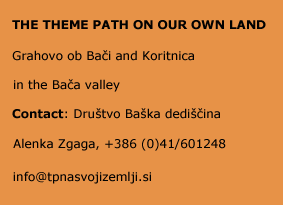FILMING IN THE BAČA VALLEY
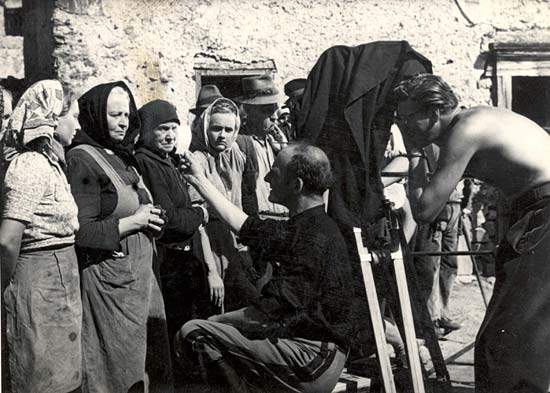 Štiglic and the film crew. (del Fabbro)
Štiglic and the film crew. (del Fabbro)
Many scenes were filmed in the Bača Valley in the austere conditions following World War II. The shooting in the Bača Valley brought together the film crew and the locals, and both sides cherish the memory of this pioneer episode of Slovene filmmaking.
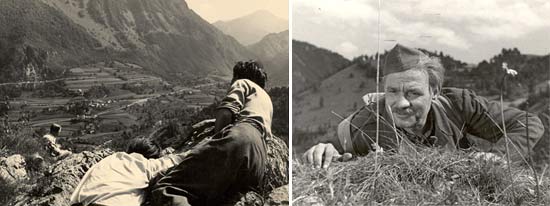 |
|
| Scouting locations in April 1947. (del Fabbro) | Partisan Sova. (del Fabbro) |
The film crew first visited the Bača Valley to scout filming locations in the spring of 1947. France Štiglic: “… my imagination was already selecting the most attractive scenes, combining them into film sequences … Below us lay the valley. I could not capture all of it with my eyes but had to trace it by turning to the extreme edges, which framed the valley like film models in transparent sunlight. At the bottom of the valley shimmered the narrow river, with the road and railway running along it and crossing one another in places. Below the rock faces and steep hay meadows village roofs sparkled on steep slopes. At this moment the partisan Sova from the script became alive in me and I could hear him say with love and pride: “Stane, look at her, that’s our valley!” Yes, that’s our valley! It is the setting of our film’s story.” (Stari bomo dvajset let II, Ekran, 1964, pps. 1692–1696)
France Štiglic was probably invited to join the first film crew due to his experience with the Yugoslav-Soviet coproduction In the Mountains of Yugoslavia and because he had been awarded a Bronze Lion at the Venice Film Festival for his short film Youth Builds. In the rejuvenated crew he was appointed main director and even though he was only twenty-eight at the time, he didn’t shrink from the challenge. Before the shooting started, six members of the film crew were sent to Czechoslovakia on a short training course, while the other crew members were largely without formal film education. The technical team often had to improvise. The sound engineer Rudi Omota, for instance, constructed a sound recording device all by himself. The actors had to learn film acting on the spot - in the Bača Valley. “The hardest thing was to work with the students of the Acting Academy. All of them were young Hamlets and Oresteses. It always took them a few days to speak natural Slovene again. I think that the theatre actors learned a great deal from the film, above all to be authentic and natural.” (France Štiglic, Stari bomo dvajset let III, Ekran, 1964, str. 1999)
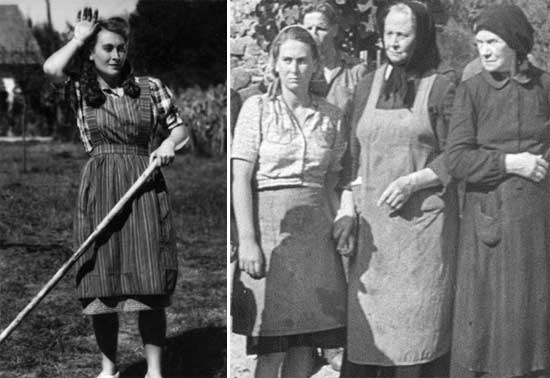 |
|
| Štefka Drolc in a newly made outfit. (del Fabbro) | Tildica in worn-out clothes among the village women. (del Fabbro) |
The making of the film On our own land benefited from the good cooperation between the crew and the locals. When the crew first arrived at the location in 1947 it quite enlivened the tranquil village life. The main crew members stayed in Most na Soči and the others with locals from Grahovo and Koritnica. Štiglic thought that the new simple peasant outfits, made for the film, were not realistic enough and the actors exchanged them with the villagers for their worn-out, patched up clothes.
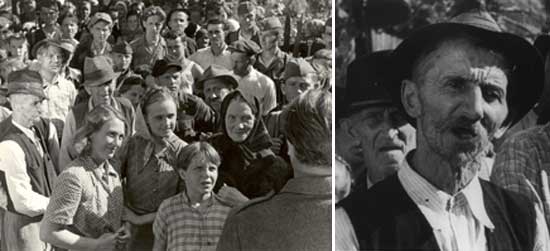 |
|
| Professional actors and locals in a mass scene. (del Fabbro) | Of all the locals, Jakob Kavčič Rusc from Grahovo played the biggest part. (del Fabbro) |
The filming required a lot of resourcefulness in the austere post-war conditions and also gave a lot of satisfaction to the participants. Both the locals and the film crew cherish the memory of the film's shooting and they were delighted to meet again when the monument to the film’s shooting was unveiled in 1975. The Association of Slovene Filmmakers commissioned it from the sculptor Peter Jovanovič.
The locals assisted the crew with logistics and provisions, and they also participated as extras in the mass scenes. “Villagers from Grahovo and Koritnica participated in the scenes showing village life. They were quite thrilled to participate, especially because the film showed what they had gone through themselves. They told us that the events following Italy’s capitulation occurred just like we filmed them. Hostages were shot or hanged in their villages. They cooperated with the liberation army when it attacked the railway and the military outpost in the village. They therefore easily related to the film scenes. But that was not all: they were also very critical of everything that they felt was not authentic... We organized film projections for them, told them what a film is, how it should be watched, and what our film would be like“ (Štiglic, Stari bomo dvajset let III, Ekran, 1964, p. 2000).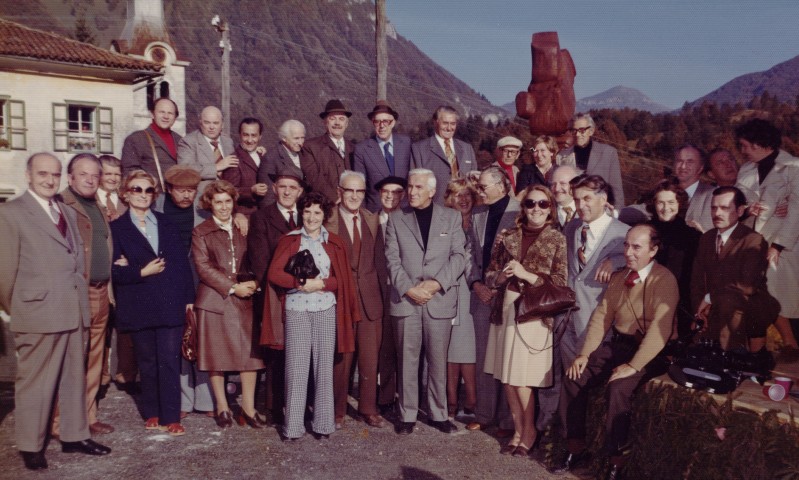 |
| The film crew in front of the monument. (A. Manfreda) |
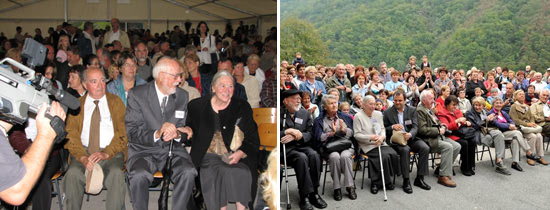 |
|
| The filmmakers at the event of 2008. (A. Zgaga) |
The filmmakers at the opening of the theme path in 2012. (I. Merljak) |
The film On our own land turned into an important part of the cultural biography of the Bača Valley. The locals are proud of the film and preserve the memory of it in the name of their annual meeting On our own land – Today. In 2008, on the 60th anniversary of the film, they invited the surviving members of the film crew to a memorial event. The villagers also cooperated in the elaboration and preparations of the theme path On our own land.
